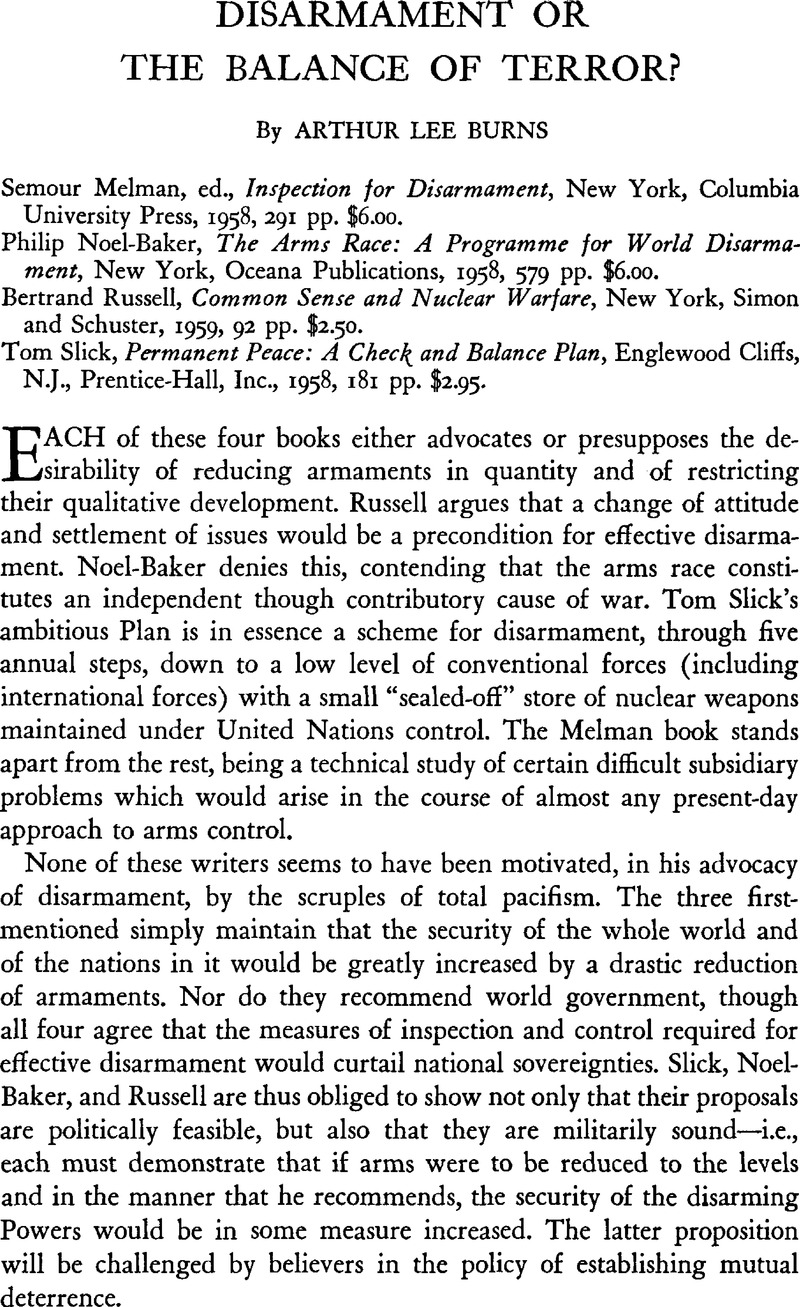No CrossRef data available.
Article contents
Disarmament or the Balance of Terror?
Published online by Cambridge University Press: 18 July 2011
Abstract

- Type
- Review Articles
- Information
- Copyright
- Copyright © Trustees of Princeton University 1959
References
1 Certain Catholics and Protestants construe the imperatives of their faith in some such way as this. Kennan, George F. states a similar position in “Foreign Policy and Christian Conscience,” Atlantic Monthly, CCIII, No. 5 (May 1959), esp. pp. 47–48.Google Scholar
2 The deterrent position is usually stated less laboriously and explicitly. See, e.g., Goodwin, G. L., Britain and the United Nations, New York, 1957, pp. 155–85Google Scholar (esp. pp. 156–57: “…the growing belief … that mutual possession of the ‘Great Deterrent’ may usher in a ‘Pax Atomica’ has now cast some doubt on the desirability as well as the feasibility of atomic disarmament.…”); and Bull, Hedley, “Disarmament and the International System,” Australian Journal of Politics and History, V, No. 1 (May 1959), pp. 41–50.Google Scholar The position is most clearly spelled out in Schilling's, Thomas C. chapter, “Surprise Attack and Disarmament,” in NATO and American Security, ed. by Knorr, Klaus, Princeton, N.J., 1959.Google Scholar Schelling specifically argues for the type of arms control that, under the balance of terror, would ensure minimum rather than maximum levels of certain armaments. The earliest work known to me that touches upon the latter and a number of other arguments developed in the present review is Amster's, WarrenA Theory for the Design of a Deterrent Air Weapon System, San Diego, Calif., Convair (General Dynamics Corp.), 1955.Google Scholar
3 Throughout this review a “point of equilibrium,” stable or unstable, in an arms race means a point at which no party has any incentive to increase or decrease its forces. An “explosive” area is one in which one or more parties have a motive for making war immediately. Points of unstable equilibrium are non-explosive points in the lower ranges of a generally explosive area. Points of stable equilibrium occur in non-explosive areas, and ratios of forces greater than mose at points of stable equilibrium fall in ever-less-explosive areas.
4 These assumptions seem generally to be held in the United Kingdom, the United States, and the USSR. They are questioned in the present writer's Power Politics and the Growing Nuclear Club, Policy Memorandum No. 20, Center of International Studies, Princeton University, June 8, 1959.
5 For the contrary view—that the qualitative arms race is essentially non-explosive— see Huntington, Samuel P., “Arms Races: Prerequisites and Results,” in Public Policy: Year Book of the Graduate School of Public Administration of Harvard University, 1958, Cambridge, Mass., pp. 41–86.Google Scholar
6 Noel-Baker, , The Arms Race, pp. 34–37.Google Scholar
7 Quoted in The Arms Race, p. 29.




